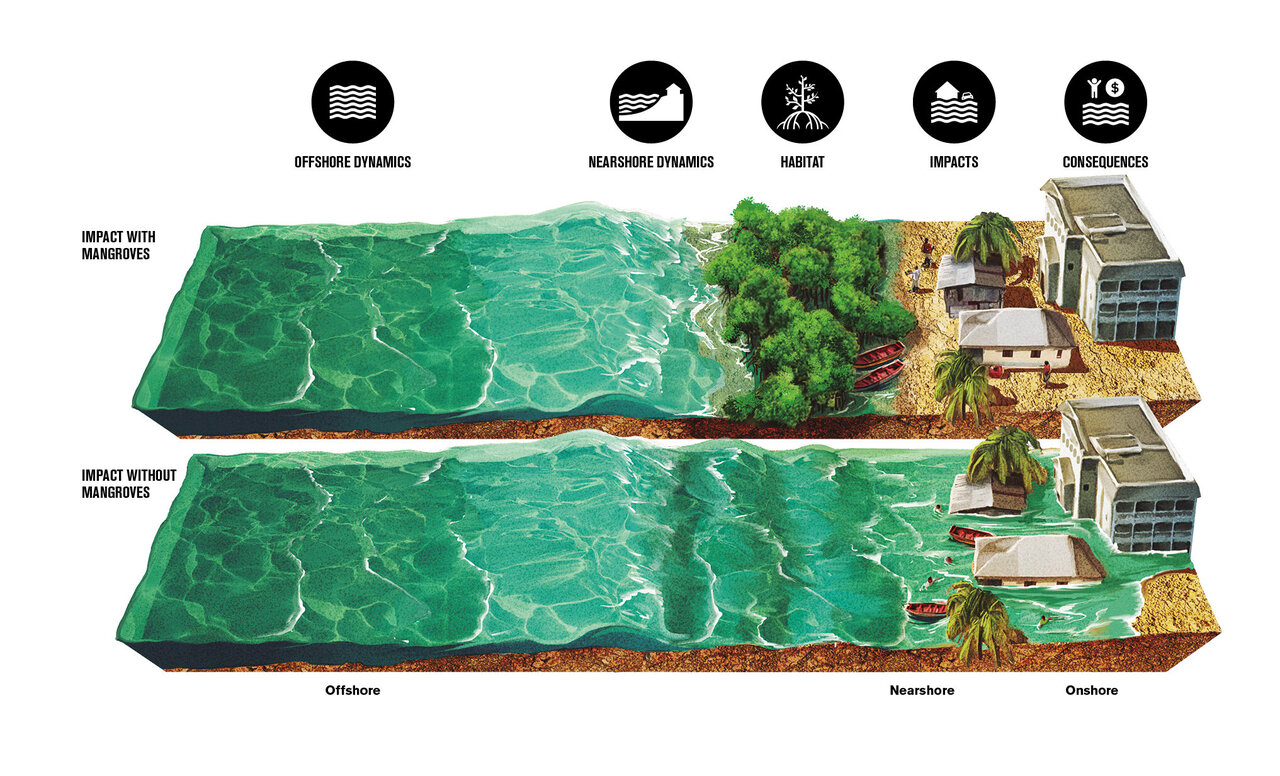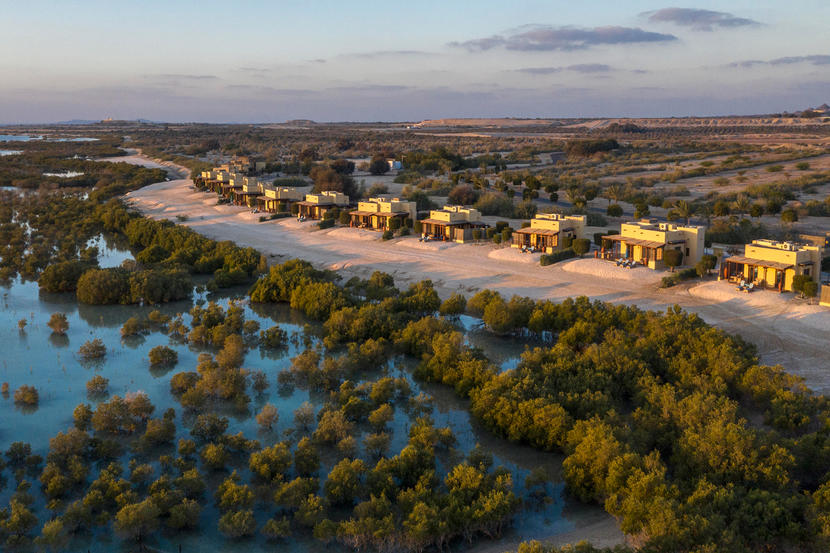A threat and a solution – tourism’s role in mangrove protection
Mangroves are a vital ecosystem that benefit our environment, economy, and communities. Yet they are severely under threat. An estimated 67% of historical mangrove habitat has been lost or degraded worldwide, with 20% occurring since 1980. One of the biggest threats to mangroves is the tourism industry. Here's how we can turn this ship around.
By Gail Sucharitakul & Jamie Hardy | July 26, 2021
Mangroves support rich biodiversity and high levels of productivity, supplying seafood at capacities large enough to feed millions of people. Fisheries and other sectors, economies, and communities are the world are dependent on the restoration and protection of these vital ecosystems.
Mangroves are also key part of the climate resilience toolkit, acting as natural barriers to protect shorelines from erosion. They can reduce wave height by up to 66%, which is becoming increasingly important as the frequency of severe storms has risen by 40%.
In addition, they act as vast carbon sinks, absorbing up to five times more carbon than land-based forests. A recent report found that mangroves have the potential to sequester 24m tonnes of carbon per year, the equivalent to the annual emissions of France or Poland.
However, unsustainable use and increasing economic development pressure have led to an alarming loss of global mangrove cover. If things carry on as they are, every unprotected mangrove forest will disappear by the end of this century.
The main causes are the logging of mangroves for timber and charcoal production and the extension of usable areas for settlements, agriculture and aquaculture. But tourism has also played a huge part in their demise.

Tourism’s impact
The tourism sector contributes to 10.4% of global GDP and 11% global greenhouse gas emissions. The case for decarbonization is therefore abundantly clear but the sector’s high dependence on the world’s coastlines means that climate adaptation is also crucial.
The importance of mangroves and tourism are globally uneven. Small Island Developing States (SIDS) have significantly higher exposure to climate change and their respective tourism sectors often exceed 40% of GDP.
This means that growth of tourism in these nations has had large impacts on mangrove degradation. A prime example is Aruba that, primarily due to hotel developments, has lost 70% of its mangroves in the last 30 years.
Degradation also arises from tour and cruise boats that can frequent mangrove sites, and depending on the speed they travel, produce waves that can cause erosion of the river banks. The heavy scouring of sediment will eventually result in the uprooting and loss of mangrove trees.
Other environmental issues associated with mass tourism include waste and litter to run-offs and leachate, which can pollute the estuarine waters and affect the health of marine life reliant on mangroves.
The business case
So how do we influence the tourism sector to do the right thing when so much of it is in coastal areas?
Tourism contributes to a country’s socio-economic development but without a comprehensive governance framework and careful management, this development will be devasting both environmentally and socially.
The first step to changing the sectors’ impact on these ecosystems is helping identify and understand the risks.

If tourism and nature can’t coincide sustainably the impacts will be devastating environmentally and economically.
Increased operating costs
Rising sea levels and increasing extreme weather events have already increased the insurance premiums of hotels’ real estate. DiamondRock Hospitality, a Real Estate Investment Trust (REIT), saw insurance premiums increase in 35% in 2018 due to increased climate risk associated with coastal hotel assets. Whether through insurance premiums, increased regulations, service disruption, or damage repair, climate risks will increase the costs for many in the tourism industry.
Damaged destinations
Coral reefs have a global economic value of $36 billion per year or 9% of coastal tourism in the world’s coral reef countries. However, over the previous 30 years, half of all coral reefs have been lost. Further degradation could risk reduced demand for coastal tourism. Mangroves not only protect coral reefs but also provide vast biodiversity contributing to the marine ecosystem from which considerable tourism is derived. A leading initiative to tackle this is the Global Fund for Coral Reefs (GFCR), an investment vehicle that funds innovative business models that increase the resilience of coral reefs and the communities that depend on them.
Compromised image and branding
Mangrove degradation can also have negative consequences on companies’ branding and image. Studies suggest that there is a positive connection in tourism between sustainability and revisiting or recommending a location. Tourism actors therefore risk bearing the opportunity cost of neglecting mangrove ecosystems.
Through mitigating these risks and protecting and restoring mangroves, the tourism industry create a triple bottom line (TBL) effect for coastal tourism sites. Improving ecosystems and adopting more sustainable practices may attract more tourism demand, driving up income and creating jobs for the surrounding economy.
Leaders
Several key actors across the tourism sector have woken up to the importance of mangroves not just for sustainability targets, but also the direct risks posed to their businesses’ bottom line.
Sri Lanka’s tourism has almost doubled as a percentage of GDP over the past decade and over 2.7 million people depend on fisheries for their livelihood. Mangrove ecosystems are inextricably linked with both sectors. In addition, the protective value of mangroves is $2,100 per household per year against coastal floods. The importance of mangroves led Sri Lanka to commit to becoming the first country to replant all mangrove forests. Sri Lanka is providing microloans and education to communities in exchange for mangrove conservation and propagated 700,000 mangrove seedlings in 2017.
Saint Lucia is a Caribbean island with a tourism sector contributing over 65% of GDP. The island has a vast mangrove ecosystem with the largest forest, Mankote forest, stretching over 40 hectares of land. However, approximately 10% of the forest has been degraded due to poor water circulation. The forest has also been under threat from proposed developments of large resorts and golf courses.
In response to this, the Eastern Caribbean Marine Managed Areas Network partnered with scientists, government agencies and community members to successfully plant 4,000 mangrove seedlings. The forest is now expected to fully recover, bringing coastal protection to southern Saint Lucia and boosting local marine ecosystems.
Iberostar group is a privately held hotel company committed to carbon neutral operations by 2030. Recent programmes include a resort in the Dominican Republic planting over 1,500 mangroves. The company is leveraging its 80% seafront portfolio and the advantages of mangrove ecosystems, by placing mangroves at the core if its sustainability strategy.
Planterra is a community tourism organization that has partnered with ‘Make a Difference Travel’ to provide sustainable homestays on an island in the Philippines. The partnership has converted 17 homes into community run homestays where tourists participate in mangrove planting. Mangrove restoration is hugely beneficial to the island community who are heavily reliant upon the fishing industry.
The way forward
Large global initiatives are also encouraging positive developments in ecosystem conservation and climate resilience. The UN has set a target to protect and conserve 30% of global land and 30% of Oceans by 2030.
The Nature Positive campaign is aiming to have net positive global biodiversity by 2030 in order to preserve vital ecosystems. Mangroves are a key ecosystem in determining the success of such initiatives and the tourism industry can play a crucial role in their preservation and restoration.
Actors within tourism should leverage mangrove ecosystems surrounding their operations, assets, or region. The unique exposure to both climate related risk and mangrove ecosystems, provides an exclusive opportunity for the tourism industry.
To maximize this opportunity, companies and destinations should:
- Identify the company or destination specific risk profile for mangrove degradation as well as assessing opportunities and potential benefits for local mangrove restoration.
- Define the role of mangrove protection and restoration within the company / destinations carbon reduction targets and climate change mitigation, adaptation and resilience strategy.
- Establish a goal or target for mangrove protection, restoration, and promotion. Then commit to that target
- Develop an implementation roadmap to execute the strategy, and continuously track and monitor progress with clear metrics
Mangrove conservation is aligned with the incentives of the tourism industry and can be a major tool in the industry’s road to climate mitigation, adaptation and resilience. The future of mangrove ecosystems is dependent on the actions that we take now to protect the mangrove forests we have left and continue to repair the degradation caused from the past few decades.
The Race to Resilience and mangroves
Earlier this January, Alok Sharma, COP26 President designate, launched the High Level Climate Champions’ Race to Resilience campaign at the Climate Adaptation Summit. The campaign aims to catalyse step-change in global ambition for climate resilience, putting people and nature first in pursuit of a resilient world where we don’t just survive climate shocks and stresses, but thrive in spite of them. Mangroves are pivotal to this and as such the Global Mangrove Alliance is a partner initiative of the campaign. The Global Mangrove Alliance brings together experts, governments, businesses, and NGOs to develop a comprehensive, coordinated, global approach towards mangrove conservation at a scale that matters.
Gail Sucharitakul is Tourism Sector Lead, Climate Champions. Jamie Hardy is Tourism Sector Support, Climate Champions.



